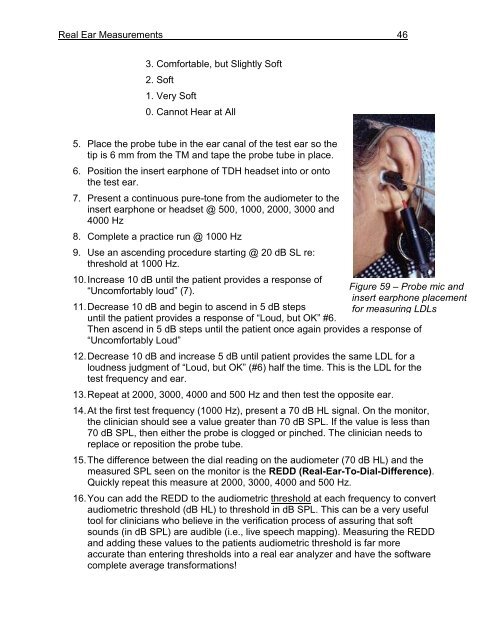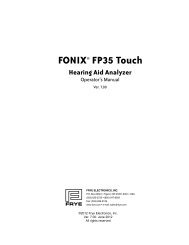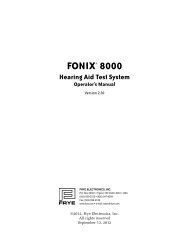Using the FONIX 7000 to Verify Coupler and Real-Ear Performance ...
Using the FONIX 7000 to Verify Coupler and Real-Ear Performance ...
Using the FONIX 7000 to Verify Coupler and Real-Ear Performance ...
Create successful ePaper yourself
Turn your PDF publications into a flip-book with our unique Google optimized e-Paper software.
<strong>Real</strong> <strong>Ear</strong> Measurements 46<br />
3. Comfortable, but Slightly Soft<br />
2. Soft<br />
1. Very Soft<br />
0. Cannot Hear at All<br />
5. Place <strong>the</strong> probe tube in <strong>the</strong> ear canal of <strong>the</strong> test ear so <strong>the</strong><br />
tip is 6 mm from <strong>the</strong> TM <strong>and</strong> tape <strong>the</strong> probe tube in place.<br />
6. Position <strong>the</strong> insert earphone of TDH headset in<strong>to</strong> or on<strong>to</strong><br />
<strong>the</strong> test ear.<br />
7. Present a continuous pure-<strong>to</strong>ne from <strong>the</strong> audiometer <strong>to</strong> <strong>the</strong><br />
insert earphone or headset @ 500, 1000, 2000, 3000 <strong>and</strong><br />
4000 Hz<br />
8. Complete a practice run @ 1000 Hz<br />
9. Use an ascending procedure starting @ 20 dB SL re:<br />
threshold at 1000 Hz.<br />
10. Increase 10 dB until <strong>the</strong> patient provides a response of<br />
“Uncomfortably loud” (7).<br />
11. Decrease 10 dB <strong>and</strong> begin <strong>to</strong> ascend in 5 dB steps<br />
until <strong>the</strong> patient provides a response of “Loud, but OK” #6.<br />
Then ascend in 5 dB steps until <strong>the</strong> patient once again provides a response of<br />
“Uncomfortably Loud”<br />
12. Decrease 10 dB <strong>and</strong> increase 5 dB until patient provides <strong>the</strong> same LDL for a<br />
loudness judgment of “Loud, but OK” (#6) half <strong>the</strong> time. This is <strong>the</strong> LDL for <strong>the</strong><br />
test frequency <strong>and</strong> ear.<br />
13. Repeat at 2000, 3000, 4000 <strong>and</strong> 500 Hz <strong>and</strong> <strong>the</strong>n test <strong>the</strong> opposite ear.<br />
Figure 59 – Probe mic <strong>and</strong><br />
insert earphone placement<br />
for measuring LDLs<br />
14. At <strong>the</strong> first test frequency (1000 Hz), present a 70 dB HL signal. On <strong>the</strong> moni<strong>to</strong>r,<br />
<strong>the</strong> clinician should see a value greater than 70 dB SPL. If <strong>the</strong> value is less than<br />
70 dB SPL, <strong>the</strong>n ei<strong>the</strong>r <strong>the</strong> probe is clogged or pinched. The clinician needs <strong>to</strong><br />
replace or reposition <strong>the</strong> probe tube.<br />
15. The difference between <strong>the</strong> dial reading on <strong>the</strong> audiometer (70 dB HL) <strong>and</strong> <strong>the</strong><br />
measured SPL seen on <strong>the</strong> moni<strong>to</strong>r is <strong>the</strong> REDD (<strong>Real</strong>-<strong>Ear</strong>-To-Dial-Difference).<br />
Quickly repeat this measure at 2000, 3000, 4000 <strong>and</strong> 500 Hz.<br />
16. You can add <strong>the</strong> REDD <strong>to</strong> <strong>the</strong> audiometric threshold at each frequency <strong>to</strong> convert<br />
audiometric threshold (dB HL) <strong>to</strong> threshold in dB SPL. This can be a very useful<br />
<strong>to</strong>ol for clinicians who believe in <strong>the</strong> verification process of assuring that soft<br />
sounds (in dB SPL) are audible (i.e., live speech mapping). Measuring <strong>the</strong> REDD<br />
<strong>and</strong> adding <strong>the</strong>se values <strong>to</strong> <strong>the</strong> patients audiometric threshold is far more<br />
accurate than entering thresholds in<strong>to</strong> a real ear analyzer <strong>and</strong> have <strong>the</strong> software<br />
complete average transformations!
















